Graffiti - art and free speech, or a crime of trespass and vandalism? Which is it?
That depends on who you talk to, said Pontus Agren, a former, prolific graffiti writer in his youth who went on to form an anti-graffiti program in 2001, then later earned a degree in criminology at Simon Fraser University.
"Putting any type of ink on a wall without the consent of the owner is naturally going to warrant a criminal charge," said Agren. "But the hip-hop graffiti artists do this because it's part of their language in their subculture. They are talking to each other. They are seeking recognition and fame. Knowing that, you might see the crime in a different way.
"The guys in the graffiti subculture I've worked with they feel like it's an expression. If you come from a government perspective, it's deviant."
But why target private and public property with spray cans, markers and other media? "I've talked with so many of these kids (graffiti writers), they've come from broken homes, they've been bullied at school and feel they don't have a voice in our society,"
he said. "And one way to get heard is by putting your name up on a wall. That's why it becomes a subculture and a way of getting recognition. "We talk about embracing all the people within our community in order to make our community stronger. And it's these kids who get brushed aside."
But it's also that group that's likely not to consider what they do as art or free expression, but merely a way of, "getting some recognition in a society so heavily populated where kids feel they've lost their identity," Agren said.
And with that desire to be heard comes a form of addiction for many graffiti writers. "That's why a lot of the kids stay in it so long," he said. "They want that fame. "For me, it was hard to get out of that, too. I had to get caught several times."
Eventually, Agren, of Surrey, was diverted to a restorative justice process that put him in touch with his victims and an opportunity to develop empathy for those he offended. Ultimately, that helped Agren work his way out of the graffiti life.
As for his impressions of the recent graffiti covering Richmond's cenotaph, Agren said, from what he's seen, it was simply vandalism. "These are people who just want to get
recognized for being disruptive," he said. "They are not putting their names out there like they might do in the hip-hop world, where they want to get known for their artistic approach.
"This is scribbles across a cenotaph. They are not leaving their calling card. It's purely just damage to be destructive."
See
He explained that in hip-hop culture, there are some tacit rules for where graffiti is not placed.
"Some of the graffiti writers do have some morals," Agren said, adding most official memorials are on that no-tag list.



